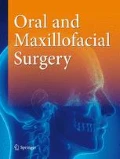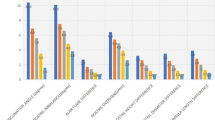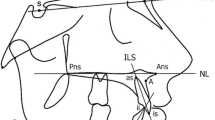Abstract
Objective
Primary cleft lip closure can be achieved by use of different types of surgery. The procedures of Millard, Veau, and Delaire are among the techniques most frequently performed worldwide. The factors which affect development of the columella have not been studied, however.
Setting
University Hospital of Leipzig, Germany, Department of Oral, Craniomaxillofacial and Facial Plastic Surgery.
Patients, participants
In a comparative, retrospective, non-randomised study, we obtained anthropometric details from photographs of 120 unilateral and bilateral cleft patients after cleft lip closure by use of the techniques of Millard or Veau (n = 60) and Delaire (n = 60). Length and shape of the columella was assessed twice—first at the age of 10 months and again at the age of 10 years. Anthropometric characteristics of columella morphology and development were compared between the two groups.
Results
At the age of 10 months, the ratio of nasal height to width (interalar distance) was significantly different for unilateral and bilateral cases, and results were better for the Delaire groups (p = 0.001 unilateral and p > 0.001 bilateral). This effect was no longer apparent at 10-year follow up. Another index which tended to indicate better results in the Delaire groups was the nasal width index. In the summary of the anthropometric values investigated, however, differences between the Millard or Veau group and the Delaire group were marginal.
Conclusion
Cleft lip closure by the technique of Millard for unilateral cleft lips and of Veau for bilateral cases is neither better nor worse than Delaire cheiloplasty for unilateral and bilateral clefts.











Similar content being viewed by others
References
Gundlach KK, Maus C (2006) Epidemiological studies on the frequency of clefts in Europe and world-wide. J Craniomaxillofac Surg 34(Suppl 2):1–2, PMID: 17071381
Anastassov Y, Chipkov C (2003) Analysis of nasal and labial deformities in cleft lip, alveolus and palate patients by a new rating scale: preliminary report. J Craniomaxillofac Surg 31:299–303, PMID: 14563331
Tanikawa DY, Alonso N, Rocha DL (2010) Evaluation of primary cleft nose repair: severity of the cleft versus final position of the nose. J Craniofac Surg 21:1519–1524. doi:10.1097/SCS.0b013e3181ec087e
Salyer KE, Genecov ER, Genecov DG (2003) Unilateral cleft lip-nose repair: a 33-year experience. J Craniofac Surg 14:549–558, PMID: 12867873
Bhattacharya S, Khanna V, Kohli R (2009) Cleft lip: the historical perspective. Indian J Plast Surg 42(Suppl):S4–S8. doi:10.4103/0970-0358.57180
Malgaigne J (1844) Du bec-de-lièvre. J Chir (Paris) 2:1–6
Mirault G (1844) Lettre sur l’operation du bec-de-lièvre. J Chir (Paris) 2:257–265
Bill J, Proff P, Bayerlein T, Weingaertner J, Fanghanel J, Reuther J (2006) Treatment of patients with cleft lip, alveolus and palate—a short outline of history and current interdisciplinary treatment approaches. J Craniomaxillofac Surg 34(Suppl 2):17–21, PMID: 17071385
Hoffmann-Axthelm W (1995) Die Geschichte der Mund-Kiefer-Gesichtschirurgie. Quintessenz-Verlag, Berlin Chicago London, pp 27:189–77;225
Millard DR Jr (1958) A radical rotation in single harelip. Am J Surg 95:318–322, PMID: 13487963
Delaire J (1978) Theoretical principles and technique of functional closure of the lip and nasal aperture. J Maxillofac Surg 6:109–116, PMID: 276551
Delaire J, Precious D (1986) Influence of the nasal septum on maxillonasal growth in patients with congenital labiomaxillary cleft. Cleft Palate J 23:270–277, PMID: 3464365
Delaire J, Precious DS, Gordeef A (1988) The advantage of wide subperiosteal exposure in primary surgical correction of labial maxillary clefts. Scand J Plast Reconstr Surg Hand Surg 22:147–151, PMID: 3187449
Millard DR Jr (1964) Rotation-advancement principle in cleft lip closure. Cleft Palate J 12:246–252, PMID: 14140821
Amaratunga NA (1988) A comparison of Millard’s and LeMesurier’s methods of repair of the complete unilateral cleft lip using a new symmetry index. J Oral Maxillofac Surg 46:353–356, PMID: 3163367
Marcusson A, Paulin G, Ostrup L (2002) Facial appearance in adults who had cleft lip and palate treated in childhood. Scand J Plast Reconstr Surg Hand Surg 36:16–23, PMID: 11925823
Meyer-Marcotty P, Stellzig-Eisenhauer A (2009) Dentofacial self-perception and social perception of adults with unilateral cleft lip and palate. J Orofac Orthop 70:224–236. doi:10.1007/s00056-009-8813-9
Oosterkamp BC, Dijkstra PU, Remmelink HJ, van Oort RP, Goorhuis-Brouwer SM, Sandham A, de Bont LG (2007) Satisfaction with treatment outcome in bilateral cleft lip and palate patients. Int J Oral Maxillofac Surg 36:890–895, PMID: 17766083
Marcusson A (2001) Adult patients with treated complete cleft lip and palate. Methodological and clinical studies. Swed Dent J Suppl 1–57, PMID: 11400538
Hemprich A (2000) Secondary operations in lip-jaw-palate clefts. Mund Kiefer Gesichtschir 4(Suppl 1):S61–S67, PMID: 10938644
Brunner M, Georgopoulou A, Verres R, Komposch G, Mussig E (2004) Psychosocial problems and coping strategies of young patients with cleft lip and palate. Psychother Psychosom Med Psychol 54:423–430, PMID: 15494892
Fadeyibi IO, Coker OA, Zacchariah MP, Fasawe A, Ademiluyi SA (2012) Psychosocial effects of cleft lip and palate on Nigerians: the Ikeja-Lagos experience. J Plast Surg Hand Surg 46:13–18. doi:10.3109/2000656X.2011.643027
Hunt O, Burden D, Hepper P, Johnston C (2005) The psychosocial effects of cleft lip and palate: a systematic review. Eur J Orthod 27:274–285, PMID: 15947228
Sinko K, Jagsch R, Prechtl V, Watzinger F, Hollmann K, Baumann A (2005) Evaluation of esthetic, functional, and quality-of-life outcome in adult cleft lip and palate patients. Cleft Palate Craniofac J 42:355–361, PMID: 16001915
Andretto AC (2007) The central role of the nose in the face and the psyche: review of the nose and the psyche. Aesthetic Plast Surg 31:406–410, PMID: 17551776
Babuccu O, Latifoglu O, Atabay K, Oral N, Cosan B (2003) Sociological aspects of rhinoplasty. Aesthetic Plast Surg 27:44–49, PMID: 12789458
Huffman WC, Lierle DM (1946) Studies on the pathologic anatomy of the unilateral harelip nose. Plast Reconstr Surg 4:225–234, PMID: 18131353
Shaw WC, Semb G, Nelson P, Brattstrom V, Molsted K, Prahl-Andersen B, Gundlach KK (2001) The Eurocleft project 1996–2000: overview. J Craniomaxillofac Surg 29:131–140, PMID: 11465251
Horswell BB, Pospisil OA (1995) Nasal symmetry after primary cleft lip repair: comparison between Delaire cheilorhinoplasty and modified rotation-advancement. J Oral Maxillofac Surg 53:1025–1030, PMID: 7643272
Kohout MP, Aljaro LM, Farkas LG, Mulliken JB (1998) Photogrammetric comparison of two methods for synchronous repair of bilateral cleft lip and nasal deformity. Plast Reconstr Surg 102:1339–1349, PMID: 9773988
Reddy GS, Webb RM, Reddy RR, Reddy LV, Thomas P, Markus AF (2008) Choice of incision for primary repair of unilateral complete cleft lip: a comparative study of outcomes in 796 patients. Plast Reconstr Surg 121:932–940. doi:10.1097/01.prs.0000299282.63111.3f
Reddy SG, Reddy RR, Bronkhorst EM, Prasad R, Kuijpers Jagtman AM, Berge S (2010) Comparison of three incisions to repair complete unilateral cleft lip. Plast Reconstr Surg 125:1208–1216. doi:10.1097/PRS.0b013e3181d45143
Farkas LG, Hajnis K, Posnick JC (1993) Anthropometric and anthroposcopic findings of the nasal and facial region in cleft patients before and after primary lip and palate repair. Cleft Palate Craniofac J 30:1–12, PMID: 8418865
Nagy K, Mommaerts MY (2007) Analysis of the cleft-lip nose in submental-vertical view, part I—reliability of a new measurement instrument. J Craniomaxillofac Surg 35:265–277, PMID: 17870608
Farmand M (2002) Lip repair techniques and their influence on the nose. Facial Plast Surg 18:155–164, PMID: 12152134
Millard D (1976) Cleft craft: the evolution of its surgery. Little Brown, Boston
Veau V (1938) Bec-de liévre, forms clinique, chirurgie. Editeur Masson, Paris
Ettorre G, Weber M, Schaaf H, Lowry JC, Mommaerts MY, Howaldt HP (2006) Standards for digital photography in cranio-maxillo-facial surgery—part I: basic views and guidelines. J Craniomaxillofac Surg 34:65–73, PMID: 16427297
Farkas LG, Posnick JC (1992) Growth and development of regional units in the head and face based on anthropometric measurements. Cleft Palate Craniofac J 29:301–302, PMID: 1643056
Liou EJ, Subramanian M, Chen PK, Huang CS (2004) The progressive changes of nasal symmetry and growth after nasoalveolar molding: a three-year follow-up study. Plast Reconstr Surg 114:858–864, PMID: 15468390
Jeong HS, Lee HK, Shin KS (2012) Correction of unilateral secondary cleft lip nose deformity by a modified Tajima’s method and several adjunctive procedures based on severity. Aesthetic Plast Surg 36:406–413. doi:10.1007/s00266-011-9788-7
McDaniel JM, Alleyne B, Gosain AK (2013) Secondary cleft nasoplasty at primary school age: quantitative evaluation of the efficacy of resorbable plates. Plast Reconstr Surg 132:933–943. doi:10.1097/PRS.0b013e3182a053f1
Wang TD (2010) Secondary rhinoplasty in unilateral cleft nasal deformity. Clin Plast Surg 37:383–387. doi:10.1016/j.cps.2009.12.013
Kim JB, Strike P, Cadier MC (2011) A simple assessment method for auditing multi-centre unilateral cleft lip repairs. J Plast Reconstr Aesthet Surg 64:195–200. doi:10.1016/j.bjps.2010.04.020
Lazarus DD, Hudson DA, van Zyl JE, Fleming AN, Fernandes D (1998) Repair of unilateral cleft lip: a comparison of five techniques. Ann Plast Surg 41:587–594, PMID: 9869130
Zaleckas L, Linkeviciene L, Olekas J, Kutra N (2011) The comparison of different surgical techniques used for repair of complete unilateral cleft lip. Medicina (Kaunas) 47:85–90, PMID: 21734440
Mosmuller DG, Griot JP, Bijnen CL, Niessen FB (2013) Scoring systems of cleft-related facial deformities: a review of literature. Cleft Palate Craniofac J 50:286–296. doi:10.1597/11-207
Olesen OV, Paulsen RR, Hojgaard L, Roed B, Larsen R (2012) Motion tracking for medical imaging: a nonvisible structured light tracking approach. IEEE Trans Med Imaging 31:79–87. doi:10.1109/TMI.2011.2165157
Schwenzer-Zimmerer K, Chaitidis D, Berg-Boerner I, Krol Z, Kovacs L, Schwenzer NF, Zimmerer S, Holberg C, Zeilhofer HF (2008) Quantitative 3D soft tissue analysis of symmetry prior to and after unilateral cleft lip repair compared with non-cleft persons (performed in Cambodia). J Craniomaxillofac Surg 36:431–438. doi:10.1016/j.jcms.2008.05.003
Author information
Authors and Affiliations
Corresponding author
Rights and permissions
About this article
Cite this article
Yildirim, V., Kaiser, J., Hemprich, A. et al. Dependence of columella development on the technique used for primary cleft lip closure. Oral Maxillofac Surg 19, 165–175 (2015). https://doi.org/10.1007/s10006-014-0472-3
Received:
Accepted:
Published:
Issue Date:
DOI: https://doi.org/10.1007/s10006-014-0472-3




